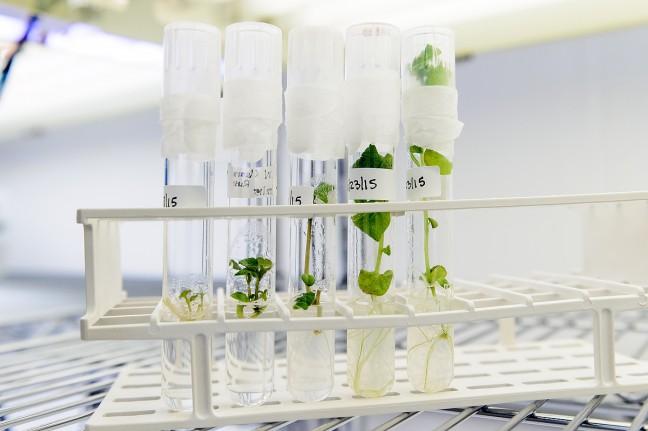For the last decade, astrobotanist Simon Gilroy and the Gilroy Lab have spearheaded the University of Wisconsin’s research on outer space plant growth, and with the future of deep space exploration rapidly approaching, the need for plants in space as sources of food and oxygen is sure to follow.
NASA reported they are currently in the beginning phases of the first deep space exploration mission, called the Deep Space Gateway. The mission is set to reach destinations beyond the Moon, such as Mars, in the late 2020s.
With this in mind and through years of research, Gilroy and his lab have engineered plants on Earth to withstand the stress of outer space, and hope to further the possibility of deep space exploration by studying how plants respond to the complex environment. The goal: To produce food for astronauts and people living on the Moon or, one day, Mars.
Earlier this month, the results of a Gilroy Lab research study, in collaboration with NASA, was published. The research sought to understand the effects of microgravity on the growth of Arabidopsis seedlings grown on board the International Space Station.
The Lab Report: Investigating how bacteria understand environmental signals
Richard Barker, a research assistant in the lab, explained the long term goal is now to transfer the technology they have demonstrated with the Arabidopsis seedlings to other crops.
Barker said growing plants on board a spaceship which will not see Earth for a long time not only serves the purpose of feeding astronauts, but also provides psychological benefits. Planting and harvesting the crops can help sustain astronauts’ mental health and stability, Barker said.
But growing plants in space comes with many challenges. Gilroy said space is a very stressful environment for plants because of the lack of gravity.
Gilroy explained the structure of water molecules causes them to stick to things, but when there is no gravity, water is not absorbed into the soil or the plant easily. Instead, the water encases the surface of the plant, which stimulates the same environmental stress a plant faces when drowning in water on Earth.
“When you water a plant on Earth, you don’t think about it, but gravity makes it all work. You just take your watering can, tip it on its side, the water flows out, drops down into the soil, then it flows down through the soil and you’ve watered your plant,” Gilroy said. “You’d never think about how it works, but in space, that whole process becomes super complicated. There is no gravity to pull the water. Space is a weird place to put biology.”
The molecular pathways activated in microgravity-grown plants show involvement of “oxidative stress,” which is common in plants experiencing stresses due to pathogens or flooding while growing on Earth, Gilroy said. The lab has engineered plants on Earth to deal with oxidative stress much better than regular plants do.
Astrobotany gets a new look: New research generates fashion line
Sarah Swanson, director of the UW botany department’s Newcomb Imaging Center and a member of the Gilroy Lab, explained that by observing how gene expressions differ in plants grown in microgravity on the ISS versus plants grown on Earth, researchers have found that plants good at dealing with stress on Earth seem to be better at growing in space.
With this information and modern technology, the Gilroy Lab can monitor the level of every gene in the plant and can tweak the necessary genes so that the plant is better prepared to deal with stress.
“We’ve made informed guesses based on Earth experimentation about which genes and plant responses might be important for plants growing in space and can precisely modify gene expression in key cellular pathways to give plants an advantage when growing in microgravity,” Swanson said.
Gilroy and his lab members have sent both normal and genetically engineered Arabidopsis seedlings to the ISS in four separate missions since 2013. As Barker stated in a video by BTN LiveBIG, the Gilroy Lab is the first lab to report that the seedlings engineered for space grew better than the normal seedlings did.
NASA astronaut draws on outer space experiences to inform approach to real world
Barker said the findings from the research missions to space could also benefit farming on Earth.
“The discovery that we made about how those plants perceive that stress has the potential to be applied not only in outer space, but locally here in Wisconsin fields,” Barker said.
According to the National Oceanic and Atmospheric Administration, Madison’s rainfall has doubled in the last 40 years, with the heaviest rainfall usually occurring near the end of summer. Barker said these rain events have impacted the local agriculture and the livelihood of the city’s farmers.
By understanding how plants respond to spaceflight and by engineering them to be resistant to the stresses of outer space, which mimic the stress of flooding, they have the opportunity to create flood-resistant plants that will have an advantage in Madison’s increasingly extreme climate, he explained.
Currently, the Gilroy Lab is working on two major projects. In collaboration with Target and NASA, they will be studying how cotton responds to microgravity in space, in an attempt to improve the sustainability of the farming of cotton on Earth. Secondly, they hope to study the effects of a pathogen stimulus on plants in space to see if it could improve their growth as well.
“We are just trying to push the way and help build that roadmap that’s going to take humans to Mars,” Barker said.


















